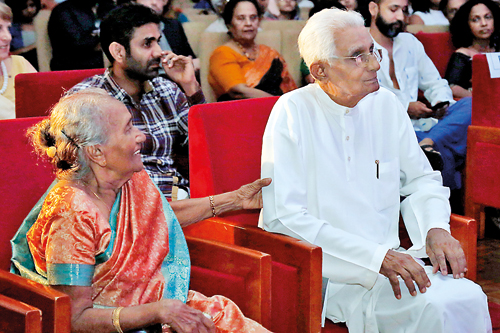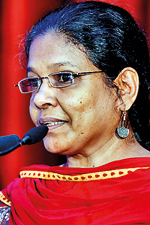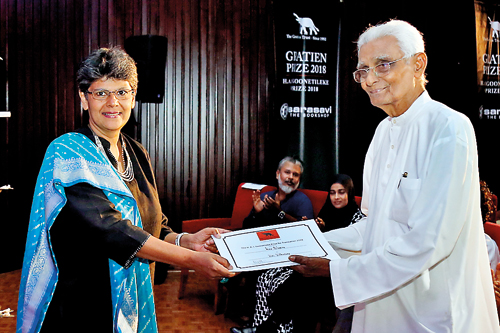Unique scholar with a rich yin and yang of cultures
View(s):
A distinctive voice: Prof. Vini Vitharana at 91. Pix by Priyantha Wickramaarachchi
The 26th Gratiaen Prize for creative writing in English, and the H. A. I. Goonetileke Prize for Translation were awarded last Sunday at the BMICH. Prof. Neloufer de Mel, Chairperson of the Board of Trustees, toasted a ‘serendipitous’ year which began with The English Patient, the 1992 Booker Prize winner by Michael Ondaatje which triggered the Gratiaen Prize, carrying home the Golden Booker as the best of all 51 Booker titles.
It was also a year of rich literary bounty for the Gratiaen- so much so that a long list had to be announced, and the exciting narratives in the short list were all fresh, novel and invigorating. Prof. de Mel said the trust will work at making sure that this will “not be a fluke- that 2018 (will not go down as) an odd year where there happened to be many good entries.”
Arun Welandawe- Prematilleke carried home the Gratiaen Prize 2018, while Prof. Vini Vitharana won the H. A. I. Goonetileke Prize.
Here Yomal Senerath-Yapa talks to Prof. Vini Vitharana
While the judges of the Gratiaen Prize this year were spoilt for choice, the H. A. I. Goonetileke Prize for Translation produced a clear, nonpareil winner: a monumental oeuvre, a translation of the beautiful work of medieval Sinhalese poetry– the Kav Silumina, named in keeping with that intricately bejewelled classic nomenclature- to mean ‘the crest-gem of poetry’.
It was a touching moment when Sumathy Sivamohan, one of the judges, paid this ode to the translator (in fact the last standing member of the Hela Havula), as well as to the medieval Sinhala monarch who composed the original, referring to it as “a work that announces a distinctive voice for itself- setting itself, the task of… being accessible to the ordinary reader and at the same time faithful to the intent of the author.
“It is a work that is distinctively different from previous translations of the original- a work that is eminently deserving of its place in the canon of translations of classical literature…
“The award goes to Kav Silumina, the story of the Bodhisattva king Kusa, translated by Vini Vitharana.”
A scintillating moment of parity which pulled everyone together- something Ian Goonetileke, humanist and lover of Lanka before being bibliophile, would have savoured.
The Kav Silumina was inscribed onto ola leaf by King Parakramabahu II (1236 AD – 1271AD), whose prowess on the battlefield matched his poetic genius.

Hearing the news: A proud moment for Mrs. Vitharana. Pix by M.A. Pushpa Kumara
To render the great poem into English was something Prof. Vini Vitharana was uniquely tailored to do. To glimpse the making of this unusual scholar, you need to turn the clocks back to 1928, when a monk of a small village in wild Tangalle was struck by an extraordinarily fortunate horoscope of a peasant child. The one request the monk made was to ‘educate this boy somehow’.
The village was remote, pitted against the thick Vanni wilderness that stretched all the way north to Elephant Pass, but a Burgher woman nearby whose name was Williams undertook to teach the boy English.
Vini grew up with an English education (later offered at Christ Church Tangalle and Mahinda College, Galle) alongside a true village existence. He imbued, along with Wordsworth and Shakespeare, the devil dancing, the yantra- mantra magic, and the huniyam (black magic). To this day, the scholar who translated Gray’s Elegy in a Country Churchyard and wrote an authoritative anthropological treatise on Sun and Moon in Sinhala Culture, firmly believes that though predicted to die in his tenth year, he was saved by exorcisms and bali thovil rituals. For, he says, “I have seen things which I cannot explain to this day.”
Without this extraordinary, rich yin and yang of cultures, we would have missed a unique scholar and his unique viewpoint which was productive of much new knowledge. A colonial British education and a mind coloured highly by vanishing native traditions meant that Vini could dip in and out of both worlds, but was essentially fascinated by the deep mysteries of his own milieu. He explored domains close to his heart, like oru- yatra (ocean-going watercraft of the Sinhalese) and Bali-yagaya (a singular study of Sinhala Buddhist folk curative ritual).

Prof. Sumathy Sivamohan
Among important theories he expounded were that the first settlers of the Maldives were Sinhalese from the southern coastal region, and that the hitherto unknown author of the great 12th century poem, Muvadevdavata, was King Gajabahu II.
Translation was an integral part of his colonial education of languages, and Vini took to it with alacrity. He began rendering English poetry into Sinhala. His body of work includes Sir Edwin Arnold’s Light of Asia and a collection including Wordsworth’s Daffodils, titled Goda Manela (our endemic swamp-lily, a daintier version of the English flower).
His most monumental translations remain however the classic Sinhala works into English. “Metered and rhymed English”- he reminds, for he would never do anything by halves. Among prose works is an unpublished magnum opus- the Saddharmaratnavaliya- running into some 1700 pages. He also translated Muvadevdavatha and Sasandavatha, Middle Age works of poetry written before Kav Silumina- not to mention all the sandesa (messenger) poems, though only four have yet been published.
Vini is not only a professor of Sinhala, but also scholar of cultural anthropology, archaeology, and a student of geography and geology. In 1961 he churned out a Sinhalese Dictionary of Geography, which remains the only work on the subject.

Chairperson of the Gratiaen Trust Prof. Neloufer de Mel presenting the H.A. I. Goonetileke Prize to Prof. Vini Vitharana
How he finds time to juggle so many academic disciplines and so many tasks has always mystified peers and students. Prof. Senake Bandaranayake the archaeologist, who was his pupil at S. Thomas’ College and was later to be his superior, asked him when he undertook translating Saddarmaratnavaliya, “Sir, how can you translate this giant work with all your other commitments?”
Vini’s answer was merely that every big thing is composed of small parts, and that he will attack those smaller parts- one by one- till all 300 parts will make up, together, the entire work. For with Vini, no single second is wasted. Each moment is dedicated to one or other interest- all of them forming a great tapestry.
His life has grown organically, harmoniously, centered on the quadrangle of his many intellectual pursuits. His amazing gentility and modesty- the same he had as a youth as when he is 91 today- never fails to move you. A bemused flicker dances in his eyes when he says “I was born to cultivate chenas and herd cattle- not to win all this acclaim.”
Last year the nation paid him yet another rare accolade- Desa Netru. How does he wear all these? The secret is he does not wear them at all- it is the intrinsic reward of learning and revealing that has always kept him going- and never those decorations offered for all his pains- or, rather, joys. As the late great Indologist Ven. Prof. Dharmavihari had said, “he has played a model role as to what an academic should be.”
Kav Silumina, “The Crest-Gem of Poetry” is published by S. Godage and Brothers.
Next week interview with ArunWelandawe Prematilleke


